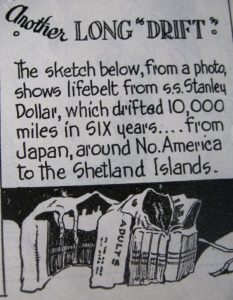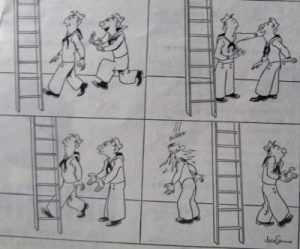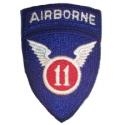Blog Archives
You could have heard a pin drop!
Once upon a time, when our politicians didn’t tend to apologize for our country’s prior actions, here’s a refresher on how some of our former patriots handled negative comment about America…
JFK’s Secretary of State, Dean Rusk, was in France in the early 60’s when DeGaulle decided to pull out of NATO. DeGaulle said he wanted all U.S. military out of France as soon as possible.
Rusk responded: “Does that include those who are buried here?”
DeGaulle did not respond… You could have heard a pin drop.
*****************
When in England, at a fairly large conference, Colin Powell was asked by the Archbishop of Canterbury if our plans for Iraq were just an example of ’empire building’ by George Bush.
Powell replied: “Over the years, the United States has sent many of its fine young men and women into great peril to fight for freedom beyond our borders. The only amount of land we have ever asked for in return is enough to bury those that did not return.” …You could have heard a pin drop.
*****************
There was a conference in France where a number of international engineers were taking part, including French and American. During a break, one of the French engineers came back into the room saying, “Have you heard the latest dumb stunt Bush has done? He has sent an aircraft carrier to Indonesia to help the tsunami victims. What does he intend to do, bomb them?”
A Boeing engineer stood up and replied quietly, “Our carriers have three hospitals on board that can treat several hundred people; they are nuclear powered and can supply emergency electrical power to shore facilities; they have three cafeterias with the capacity to feed 3,000 people 3-meals a day, they can produce several thousand gallons of fresh water from sea water each day, and they carry have a dozen helicopters for use in transporting victims and injured to and from their flight deck. We have eleven such ships; how many does France have?”…
You could have heard a pin drop.
******************
A U.S. Navy Admiral was attending a naval conference that included Admirals from the U.S., English, Canadian, Australian and French navies. At a cocktail reception, he found himself standing with a large group of officers that included personnel from most of those countries… Everyone was chatting away in English as they sipped their drinks, but a French admiral suddenly complained that whereas Europeans learn many languages, Americans learn only English. He then asked, “Why is it that we always have to speak English in these conferences rather than speaking French?”
Without hesitating, the American Admiral replied: “Maybe it’s because the Brit’s, Canadians, Aussies and Americans arranged it so you wouldn’t have to speak German.”… You could have heard a pin drop.
*****************
And of course, the meme I posted in last week’s post that brought all this back into my memory… The story of Robert Whiting, when he was 83…

Patriotism should NEVER go out of style.
############################################################################
More Quotes –


#######################################################################
Farewell Salutes –
Harlan Page Chapman – Green Valley, AZ; USMC, Vietnam, POW, Lt. Colonel (Ret.)
Donal P. Cook – Quilcene, WA; USMC, Purple Heart
Roger Fortson – Stonecrest, GA; US Air Force, Senior Airman, 4th Special Operations Squadron, KWS (FLA)
Harry Jerele – Cook County, IL; US Army, WWII, PTO, Pfc. # 20600409, POW, KIA (P.I.)
John C.G. Kerr – brn: Edinburgh, SCOT; US Air Force, Vietnam, Major #264520387, 606 AC Sq./56 ACW/7th Air Force, A-26-A pilot, KIA (Laos)
Eldon “Bud” Klein – Anacortes, WA; US Navy, WWII
Eric C. Miner – San Diego, CA; USMC, Vietnam, Desert Shield/Storm, Chief Warrant Officer-4 (Ret. 22 y.)
Richard J. Sestric – Pittsburgh, PA; US Army, MSgt. (Ret. 36 y.), Co C/187/82nd Airborne Division
John A. Spruell – Cortez, CO; US Army, Korea, Battery B//57 FA/7th Infantry Division KIA (Chosin Reservoir, NK)
James Wilson – Albuquerque, NM; US Army Air Corps, WWII, PTO, Co B/511/11th Airborne Division
#############################################################################
Yesterday was Mother’s Day here in the U.S. –
Here is my mother, circa 1949
##############################################################################

##################################################################################
MAY | MILITARY APPRECIATION MONTH
MILITARY APPRECIATION MONTH — MAY 2024
May, marked officially as Military Appreciation Month, is a special month for both those in and out of the military.
Not only do we pause on Memorial Day to remember the sacrifice and service of those who gave all, but the month also holds several other military anniversaries and events, including Military Spouse Appreciation Day and Armed Forces day.
May 1 – Loyalty Day
A day set aside for American citizens to reaffirm their loyalty to the United States
and to recognize the heritage of American freedom. Learn more…
May 1 – Silver Star Service Banner Day
A day set aside to honor our wounded, ill, and dying military personnel by
participating in flying a Silver Star Banner. Learn more…
May 2 – National Day of Prayer
The National Day of Prayer is an annual observance held on the first Thursday of
May, inviting people of all faiths to pray for the nation. Learn more…
How can you pray for the military community? Learn more…
May 8 – VE (Victory in Europe) Day
(Celebrated May 7 in commonwealth countries)
A day which marks the anniversary of the Allies’ victory in Europe during World War II
on May 8, 1945. Learn more…
May 10 – Military Spouse Appreciation Day
A day set aside to acknowledge the contributions and sacrifices of the spouses of
the U.S. Armed Forces. Learn more…
LINK – Practical insights in caring for a military home front family
May 12 – Mother’s Day
LINK – Organizations that support deployed military personnel on Mother’s Day
LINK – Coloring page for military children
May 13 – Children of Fallen Patriots Day
A day to honor the families our Fallen Heroes have left behind – especially their children. It’s a reminder to the community that we have an obligation to support the families of our Fallen Patriots. Learn more…
May 18 – Armed Forces Day
A day set aside to pay tribute to men and women who serve in the United States’
Armed Forces. Learn more…

May 27 – Memorial Day (Decoration Day)
A day set aside to commemorate all who have died in military service for the United States. Typically recognized by parades, visiting memorials and cemeteries. Learn more…
LINK – Coloring page for military children
History of Sorts blogger, Dirk Dirklein, has posted a magnificent poem for 4 May…
https://wordpress.com/read/feeds/50862033/posts/5223452622
GP is sorry to be late in posting this.
March 13 – is National K-9 Veterans Day – they are not forgotten!!
##############################################################################
Military Humor –
############################################################################
Farewell Salutes –
Henry Cervantes (100) – Fresno, CA; US Army Air Corps, WWII, Fighter pilot, 100th Bomb Group
J. Gary Cooper – Mobile, AL; USMC; Vietnam, Bronze Star, Purple Heart, DSM, MGeneral (Ret. 38 y.) /AL House of Representatives / Asst. Secretary of the Air Force under Bush/ Ambassador to Jamaica under Clinton
Lyndon J. Cosgriff-Flax – Wichita, KS; US Navy, Petty Officer 3rd Class, Yorktown Naval Weapons Station, DWS
David H. Frank – Colorado Springs, CO; US Air Force, Lt. Col. (Ret. 21 y.), pilot/ Norad
Bill Gladden (100) – London, ENG; British Army, WWII, 6th Airborne Recon Regiment
Ella “Peg” Lawrence (102) – Cincinnati, OH; US Army Air Corps WAC, WWII, Squadron Commander
Tracy M. Niksich – San Diego, CA; USMC, Vietnam, Desert Shield/Desert Storm, CWO-4 (Ret. 22 y.)
Zenon Pawlykowych – Chicago, IL; USMC, Vietnam
Hal Simons – San Diego, CA; US Navy, Korea, aviation radar / USS Midway Museum volunteer
Gary W. Trople – Bozeman, MT; USMC, Vietnam
##############################################################################
##############################################################################
Naval Tradition @ 1946
With sincere thanks to Jeanne, this post shows what “OUR NAVY’ magazine included as U.S. Naval tradition and humor in their September and December 1946 issues.


#############################################################################
Military Humor –
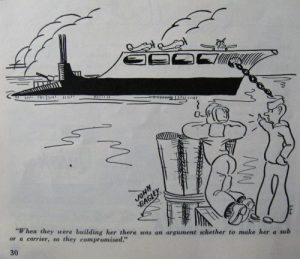
“When they were building her, there was an argument whether to make her a sub or a carrier, so they compromised.”
#############################################################################
Farewell Salutes –
Nancy Cox Allen (100) – Mansfield, OH; US Navy WAVES, WWII, Yeoman 2nd Class

US Flag at Half-staff, courtesy of Dan Antion
Colin Arslanbas – MO; USMC, SGT., Maritime Special Purpose Force/24th Expeditionary Unit, KWS (Camp Lejeune)
Raymond Casatelli (100) – Utica, NY; US Army, WWII, ETO
Austin Dishmon – Lancaster, CA; US Army, Lithuania, 3rd Infantry Division, KWS
David H. Frank – Colorado Springs, CO; US Air Force, 694 Security Squadron, recon C-130 pilot / Norad, Space Commander, Lt. Colonel (Ret.)
Marcus Jordon – Jacksonville, FL; US Air Force, Senior Airman, 38th Rescue Squadron, KWS (Guam)
Gerald L. Lester – Port Angeles, WA; USMC, Vietnam, Sgt. Major, Purple Heart
Miguel Maya – TX; USMC, Cpl., Avionics technicin, Marine Helicopter Light Attack Training Sq. 303, KWS (Camp Pendleton)
Carl E. Patterson – Falls Church, VA; US Aarmy Air Corps, WWII, B-24 & B-26 pilot / Korea, Air Force Audit Agency / Vietnam, Colonel (Ret. 30 y.)
James L. Shaw – Maplewood, MN; US Army, Sgt. Major
Gary W. Trople – Bozeman, MT; USMC, Vietnam
############################################################################
#############################################################################
Ode for the American Dead in Asia, by: Thomas McGrath
Ode for the American Dead in Asia
1.
God love you now, if no one else will ever,
Corpse in the paddy, or dead on a high hill
In the fine and ruinous summer of a war
You never wanted. All your false flags were
Of bravery and ignorance, like grade school maps:
Colors of countries you would never see—
Until that weekend in eternity
When, laughing, well armed, perfectly ready to kill
The world and your brother, the safe commanders sent
You into your future. Oh, dead on a hill,
Dead in a paddy, leeched and tumbled to
A tomb of footnotes. We mourn a changeling: you:
Handselled to poverty and drummed to war
By distinguished masters whom you never knew.
2.
The bee that spins his metal from the sun,
The shy mole drifting like a miner ghost
Through midnight earth—all happy creatures run
As strict as trains on rails the circuits of
Blind instinct. Happy in your summer follies,
You mined a culture that was mined for war:
The state to mold you, church to bless, and always
The elders to confirm you in your ignorance.
No scholar put your thinking cap on nor
Warned that in dead seas fishes died in schools
Before inventing legs to walk the land.
The rulers stuck a tennis racket in your hand,
An Ark against the flood. In time of change
Courage is not enough: the blind mole dies,
And you on your hill, who did not know the rules.
3.
Wet in the windy counties of the dawn
The lone crow skirls his draggled passage home:
And God (whose sparrows fall aslant his gaze,
Like grace or confetti) blinks and he is gone,
And you are gone. Your scarecrow valor grows
And rusts like early lilac while the rose
Blooms in Dakota and the stock exchange
Flowers. Roses, rents, all things conspire
To crown your death with wreaths of living fire.
And the public mourners come: the politic tear
Is cast in the Forum. But, in another year,
We will mourn you, whose fossil courage fills
The limestone histories: brave: ignorant: amazed:
Dead in the rice paddies, dead on the nameless hills.
From:
Selected Poems 1938-1998
##############################################################################
I HOPE VERYONE HAS HAD A BEAUTIFUL EASTER WEEK !!!!

##############################################################################
Military Humor – 
#######################################################################
Farewell Salutes –
Kenyon Brindley – Little Rock, AR; US Army Air Corps, WWII, ETO, B-24 bombardier, 703BS/$)%BG/8th Air Force, KIA (Salzungen, GER)
James D. Coogler Jr. – Livingston, IL; US Army Air Corps, WWII, ETO, flight engineer, 483BG/15th Air Force
John Daddino (100) – Clovis, CA; US Army Air Corps, WWII, ETO, 406BS, Bronze Star
Paul F. Eshelman Jr. – Pittsburgh, PA; US Army Air Corps, WWII, KIA
Alfred Hammon – Elizabeth, NJ; US Merchant Marines, WWII, PTO, Ensign / US Naval Reserve, Cmdr. (Ret.)
John A. Hutton (101) – Newton, KS; US Army Air Corps, WWII, ETO, 2nd Lt.,B-24 navigator, 763BS/460BG/15th Air Force, POW
Joe Lieberman – Stamford, CT; US Representative / US Senator
Ray K. Lilly – Matoaka, WV; US Army, Korea, Cpl., KIA (Unsan, SK)
Elijah Riddle – Loma Linda, CA; US Navy, Gunner’s mate, USS Halsey, DWS (Indian Ocean)
John T. Rocca – Watertown, MA; US Navy, WWII
##############################################################################
##############################################################################
Admiral Chester W. Nimitz
Chester W. Nimitz : “Every Man’s Admiral”
(excerpts from “OUR NAVY” magazine, 1 September 1946)
He hailed from Fredericksburg, Texas, with a sea-faring family history. It seemed natural he would choose a Navy career, but in high school, his friends made plans for the Army. Chester decided he would compete with them for West Point.
When Nimitz became eligible to take the exam, he learned there were no more appointments available in his district, except for Annapolis. The winner of a competitive examination would land him that assignment. He entered in 1901 with Royal Ingersoll and William F. Halsey, Jr.
In his first year, he showed up at the boat dock, his 150 pounds barely filling his gym suit, and tried to get a place on the boat crew. The coach thought he was a bit small, but Nimitz said, “Give me a chance.” He got that chance and became the stroke oar in the 4th crew. They did so well, the Texan was promoted to the 3rd crew that consequently kept winning. Out-weighed by 35lbs., Chester would stroke the seven men in the first boat.
At 23-years old at the Asiatic Station, he impressed his superiors as an officer fit for submarine service. With his executive abilities, remarkable memory and exceptional patience, he arrived at the 1st Submarine Flotilla for his training.
The first sub Nimitz took command of was only the second one accepted by the Navy, the Plunger. Not even named for a fish, he called it “a cross between a Jules Verne fantasy and a whale.” He then proceeded to other classes of underwater craft.
One day in March 1912, while on the Skipjack, W.J. Walsh F2c was washed overboard. He couldn’t swim. Nimitz was the first to dive into the water and reach him before he went under, as they were both being carried away in the tide. This high character and confidence his men felt here, followed Chester Nimitz through all his commands.
In WWI, he served as Chief of Staff to Admiral Samuel S. Robinson, commander of the U.S. Submarine Forces. Because of his rank, he soon found himself in the surface fleet and he continued to climb.
When Nimitz arrived on the still smoldering Pearl Harbor to take over command of the Pacific Fleet, the CinCPac staff that had served under Admiral Kimmel nervously presumed the ever-efficient Nimitz to hand them transfer orders. Instead, he said, “I did not come here to mete out punishment. I know what you men are expecting me to say. I should be honored to have the entire staff stay with me and work until victory is ours.”
He proved he could pick out top commanders by choosing Spruance to take over Halsey’s ailing Task Force. and Comdr. Eugene Fluckey, also an ex-skipper of the submarine Barb, for his personal aide. From there we know of the exploits of Admiral Chester W. Nimitz during WWII.
For a man who had no more than the average youth’s advantages, I believe we can all agree he had done quite well. Fleet Admiral Nimitz passed away 20 February 1966, 4 days before his 81st birthday.
This magazine was supplied by Jeanne Salaco, blog “everyone has a story to tell”. Thank you once again, Jeanne!
#############################################################################
Military Humor –


##############################################################################
Farewell Salutes –
Richard Berky – Bluffton, OH; US Army, WWII, ETO
William O. Chase – Sacramento, CA; US Army, Korea
John E. Deist III – Sterling, KS; US Army, Iraq, Sgt. Major (Ret. 21 y.), Bronze Star
Frank A. Kulow Jr. – Bailey, CO; US Coast Guard, WWII
Wrilshxer Mendoza – CA; US Air Force, Afghanistan, 82nd Airborne Division, (Ret. 22 y.)
I.G. Nelson – Plymouth, IA; US Army Air Corps, Japanese Occupation, 11th Airborne Division
Robert Oxman – Natick, MA; US Army Air Corps, WWII
Amelia Pagel – Temple, TX; Civilian, WWII, Lackland Air Force Base, aircraft repair
Robert T. Shultz – Arlington, VA; US Navy, Vietnam, Annapolis Class of ’50, Cmdr. (Ret. 26 y.), Bronze Star
Jack G. Thomas – Kalispell, MT; US Navy, Vietnam, fighter pilot / NV National Guard, Colonel
Marguerite Wood – NJ; Women’s Royal Naval Service, WWII
##########################################################################
MONDAY?! Uh-oh, are they looking at me now?
##############################################################################
Last Year of the Pacific War in Art
I hope you all enjoy this pictorial post. 1945 was a pivotal year for the world.

Pacific Glory” by: Nicholas Trudgian

‘Indochina Prisoners of War’ by: Donald Friend
Resources –
IHRA: for their blog and their books and prints
Jack Fellows website
Howard Brodie sketches
“WWII” by: James Jones
“WWII: A Tribute in Art and Literature” by: David Colbert
For the art of Nicholas Trudgian http://www.brooksart.com/Pacificglory.html
Roy Grinnell
https://www.roygrinnellart.com/ Barse Miller
http://www.artnet.com/artists/barse-miller/
CLICK ON IMAGES TO ENLARGE AND VIEW THE DETAIL.
############################################################################
Military Naval Humor –
##############################################################################
Farewell Salutes –
Joshua Abbott – Fulton, MS; Mississippi National Guard, Chief Warrant Officer 4, Co D/2/151st Lakota Evacuation Unit, test pilot, KWS
Bruce W. Bunce – Pavilion, NY; US Army Air Corps, WWII, PTO, 11th Airborne Division
Patricia Ann Champion (104) – Victoria, CAN; RC Air Force, WWII, parachute rigger / military nurse
Norman “Keith” Dewey – Moscow, ID; US Army Air Corps, WWII, ETO, B-17 tail gunner, 94thBG/8th Air Force
David Drake – Dubuque, IA; US Army, Vietnam, 11th Armored Calvary / science fiction author
Robert McReynolds – La Plata, MO; US Army, Korea, 188th Regiment
John O’Neill – Rochester, NY; US Army, WWII, ETO, 299th Engineer Combat Battalion
John P. Panigutti – Fairfield, CT; US Army, Vietnam, Sgt., Green Beret
Donald L. Purrier – Mansfield, MA; US Army, 11th Airborne Division
Bryan A. Zemek – Oxford, MS; Mississippi National Guard, Chief Warrant Officer 4, A Co/1/149th Aviation Regiment, AH-64 Delta Apache instructor, KWS
#####################################################################################

Seriously? It’s Monday already?
######################################################################################
Edward “Butch” O’Hare
On Feb. 20, 1942, the flattop Lexington was steaming toward the Japanese base at Rabaul, Papua New Guinea, when it was approached by two enemy flying boats. Their crews managed to signal its coordinates before American fighters flamed the planes, and the Japanese immediately launched an attack against Lexington.
That chance encounter had dire implications for the U.S., which couldn’t afford the loss of a single ship and certainly not a carrier.
American radar picked up two waves of Japanese aircraft. Mitsubishi G4M1 “Betty” bombers—good planes with experienced pilots.
Six American fighters led by legendary pilot Jimmy Thach intercepted one formation, breaking it up and downing most of the Bettys.
The second wave, however, approached from another direction almost unopposed.
Almost.
Two American fighters were close enough to intercept the second flight of eight bombers. The Navy pilots flew Grumman F4F-3 Wildcats, which like most American planes were practically obsolete at the time, certainly inferior to the best Japanese aircraft.
At this point in the war, the Navy had to rely on the men who flew them.
As the Japanese bombers dove from 15,000 feet, the guns jammed on one of the Wildcats, leaving Lexington’s fate in the hands of one young American aviator. Lt. Butch O’Hare —who’d been aboard Saratoga when she was torpedoed—had only enough .50- caliber ammunition for about 34 seconds of sustained firing.
And the Bettys were mounted with rear-facing 20mm cannons, a daunting defense. O’Hare’s aircraft may have been inferior, but his gunnery was excellent. Diving on the Japanese formation at an angle called for “deflection” shooting, but Thach had taught his men how to lead a target.
O’Hare flamed one Betty on his first pass, then came back in from the other side, picked out another and bored in.
Still too far away to help, Thach observed three flaming Japanese planes in the air at one time.
By the end of the action, O’Hare had downed five of the attacking Japanese planes and damaged a sixth, approaching close enough to Lexington that some of its gunners had fired on him.
After landing on the carrier, he approached one sailor and said, “Son, if you don’t stop shooting at me when I’ve got my wheels down, I’m going to report you to the gunnery officer.”
Thach estimated that O’Hare had used a mere 60 rounds for each plane he destroyed. It’s hard to say which was more extraordinary—his courage or his aim. Regardless, he had saved his ship.
On April 21, 1942, at a White House ceremony, Rita O’Hare draped the Medal of Honor around her husband’s neck as President Franklin Roosevelt looked on. Roosevelt promoted the pilot to lieutenant commander.
Later in the war, Butch O’Hare was killed off Tarawa while flying a pioneering night intercept against attacking Japanese torpedo planes —an exceedingly dangerous mission, employing tactics that were in their infancy.
He had volunteered. Aviators throughout the fleet reacted with disbelief at the news that Butch O’Hare was dead.
************************
There is a surprising footnote to the story.
“O’Hare” resonates with Americans today for the airport in Chicago that bears his name. An area of the airport tributes the aviator with a display to educate visitors.
Ironically, O’Hare’s father had been an associate of Al Capone. On Nov. 8, 1939, “Easy Eddie” O’Hare was gunned down a week before Capone was released from prison, supposedly for helping the government make its case against his former boss.
His son, Butch, was in flight training at the time, learning the skills he would put to use little more than two years later in the South Pacific.
CLICK ON IMAGES TO ENLARGE.
###########################################################################################
Military Humor – (For Aviators)
A HAIRY SITUATION
“AND ON A WINDY DAY, OH MY!”
#########################################################################################
Farewell Salutes –
Palmer Andrews – Los Angeles, CA; USMC, WWII, PTO, Pfc., I Co/3/5/1st Marine Division, Purple Heart / US Air Force Reserves
Richard Brinker – St. Clair, MI; US Army, WWII, PTO

One flag for every American every day.
Courtesy of Dan Antion
Myrtle Council – Shillington, PA; US Navy WAVES, WWII
Frank J. DiPiazza – Madison, WI; US Army, WWII, ETO, 42nd Infantry Division
Robert Gaylor – Bellevue, IA; US Air Force, Vietnam / SAC, NCO Academy / 5th Chief Master Sgt. / Chief of Staff of the USAF
John A. Hutton (101) – Wichita, KS; US Army Air Corps, WWII, ETO, 2nd LT., navigator, POW
Kyle Ronald Johnson – Zanesville, OH; US Army, 101th Airborne Division, Afghanistan
Samuel ‘Tickie’ Kleindorf – New Orleans, LA; US Army, Korea, 187th RCT
Frank A. Micara (100) – Brooklyn, NY; US Navy, WWII, Korea & Cuban Missile Crisis, Comdr. (Ret. 29 y.), USS Alabama & USS New Jersey
John O’Rourke – Albany, NY; US Navy, WWII, PTO, USS Roamer & USS Mount Vernon
George F. Petty – Tupelo, MS; US Army Air Corps, WWII
Virginia Spugani – Rahway, NJ; Civilian, WWII, Newark Army Base
#########################################################################################
##########################################################################################
Crossword Puzzles and WWII
The WWII home front and this generation have something in common, lock-downs. This post seemed appropriate for this day and age.
There are plenty of crossword puzzles in publications across the country, but when we think of the pinnacle of puzzledom (Not officially a word, but, perhaps, it should be?), the purveyors of the most preeminent puzzles, we bow to The New York Times (NYT).
For more than 75 years, the NYT crossword puzzle has been stumping readers with its clever clues and then sending them soaring when they finally fill in all the squares.
When did the NYT Crossword begin?
When crossword puzzles first came about in the 1920s, the NYT turned up its nose at them. In 1924, the paper ran an opinion column that dubbed them, “a primitive sort of mental exercise”.
So, what absolved the crossword puzzle in the illustrious publication’s mind and made them eat their words? Reportedly, it was after the bombing of Pearl Harbor that Lester Markel, the paper’s Sunday editor at the time, decided the country could use some levity, primitive or not.
Crosswords became an American craze in the 1920s, but it took the bombing of Pearl Harbor and the urging of The New York Times publisher Arthur Hays Sulzberger, a long-time crossword fan, to convince the features editor to run a crossword puzzle each Sunday. In a memo dated December 18, 1941, an editor conceded that the puzzle deserved space in the paper, considering what was happening elsewhere in the world and that readers might need something to occupy themselves during blackouts. The frivolous” feature, he admitted, would take people’s mind off the war and give them something to do while hunkered down in their bomb shelters.
Seventy-five years later, people continue to turn to crosswords for comfort and distraction. As the first editor of the crossword noted, “I don’t think I have to sell you on the increased demand for this kind of pastime in an increasingly worried world. You can’t think of your troubles while solving a crossword …” — Will Shortz
The first puzzle ran Sunday, February 15, 1942, and it was, in fact, a primitive pursuit, (Dictionary.com’s first definition for the adjective: “Being the first or earliest of the kind or in existence”), as they were the first major US paper to run a crossword puzzle. By 1950, the paper began running a crossword puzzle daily.
Since that time, there have only been four editors of the NYT Crossword puzzle, beginning with Margaret Farrar, who served as editor from the publication of the first puzzle until 1969. Will Weng and Eugene Maleska followed in her footsteps.
To print out a copy of the original crossword – CLICK HERE!
For the solution – CLICK HERE!
#####################################################################################
Military Humor –
SIGN POSTED IN THE ARMY RECRUITING OFFICE:
Marry a veteran girls! He can cook, make beds,
sew and is already used to taking orders!
##############################################################################
Farewell Salutes –
Eleanor Rosalyn Carter, nee: Smith – Plains, GA; Civilian, First Lady of the United States, advocate for mental health & Habitat for Humanity
Jacob “Jake” Galliher – Pittsfield, MA; US Air Force, SSgt., 353 Special Op Wing/5th Air Force, KWS (Japan)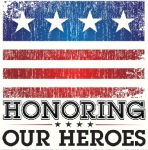
Franklin P. Hall – Leesburg, FL; US Army Air Corps, WWII, ETO, SSgt., gunner, 66/44th Bomb Group, KIA (FRA)
Henry (Heinz) A. Kissinger (100) – brn: GER; Civilian, U.S. Secretary of State, U.S. National Security Advisor
Sandra Day O’Connor – El Paso, TX; Civilian, U.S. Senator / Associate Justice of the Supreme Court
Clinton E. Smith Jr. – Wichita Falls, TX; US Army, WWII, ETO, Pfc., Co D/157/45th Infantry Division, KIA (FRA)
MH-60 Black Hawk Crash in Mediterranean Sea
Shane M. Barnes – Sacramento, CA; US Army, 160th Special Op Aviation Regiment, Chief Warrant Officer 2
Stephen R. Dwyer – Clarksville, TN; US Army, 160th Special Op Aviation Regiment, Chief Warrant Officer 3
Tanner W. Grone – Gorham, NH; US Army, 160th Special Op Aviation Regiment, SSgt.
Andrew P. Southard – Apache Junction, AZ; 160th Special Op Aviation Regiment, Sgt.
Cade M. Wolfe – Mankato, MN; US Army, 1/160th Special Op Aviation Regiment, Sgt.
##############################################################################
Courtesy of – Jack Ronald Cotner
############################################################################################################################################################
Muskogee war hero to have destroyer named in his honor; Cmdr. Ernest E. Evans | Thanksgiving
Posted on 16 November 2023
Release from the Secretary of the Navy Public Affairs
*****
15 November 2023
Secretary of the Navy (SECNAV) Carlos Del Toro announced, today, that a DDG 51 Flight III Arleigh Burke-class guided-missile destroyer will be named after World War II hero Ernest E. Evans, the first Native American in the Navy to earn the Medal of Honor and one of only two World War II destroyer captains to attain it.
Secretary Del Toro made the announcement during Native American Heritage month. Additionally, Secretary Del Toro announced that the ship’s sponsor will be U.S. Secretary of the Interior Deb Haaland, the first Native American to serve as a cabinet secretary.
“Since our nation’s founding, Native Americans, such as Ernest Evans, have volunteered to serve in our armed services. From the Revolutionary War, the Civil War, World War I and II, to Korea, Vietnam, Desert Storm, and the conflicts in Iraq and Afghanistan, Native Americans have fought with honor and distinction to preserve our union and defend our ideals of freedom and democracy, even during periods where they were not recognized as citizens of our country,” said Secretary Del Toro.”
“Today, we honor Commander Ernest Evans for his courage and ultimate sacrifice,” said Secretary Deb Haaland. “While this nation has not always welcomed them, Native Americans have consistently and honorably served in disproportionately high rates across the Armed Forces to keep us safe at home and abroad. As we honor Commander Evans with this stunning vessel, we also honor the service of Indigenous servicemembers nationwide, past and present. Native American history is American history, and today’s designation ensures that our story continues to be told.”
Ernest Edwin Evans was born on Aug. 13, 1908, in Pawnee, Oklahoma. He graduated from Central High School in Muskogee, Oklahoma, and enlisted in the U.S. Navy on May 29, 1926. After a years’ enlisted service, he was appointed to the U.S. Naval Academy, entered as a midshipman, and graduated with a Bachelor of Science degree in June 1931.
Evans spent his first decade of service in San Diego, Pensacola, and aboard seven ships. He was serving on his eighth in the East Indies when the Japanese attacked Pearl Harbor on Dec. 7, 1941, thrusting the U.S. into World War II.
In 1943, Cmdr. Evans assumed command of the USS Johnston, serving as its only commanding officer. During the commissioning ceremony, Cmdr. Evans reportedly told his crew and the audience assembled, “This is going to be a fighting ship. I intend to go in harm’s way, and anyone who doesn’t want to go along had better get off right now.”
Oct. 25, 1944, off the coast of the Philippines, Cmdr. Evans and the crew of the USS Johnston found themselves in harm’s way during the Battle of Leyte Gulf. On that day, Cmdr. Evans and his fellow destroyer captains launched an offensive attack against overwhelming odds against a much larger Japanese naval force, with the USS Johnston in the lead. Not waiting for orders, Evans commanded the crew to begin a torpedo run, drawing fire away from the carriers, directly taking hits from three powerful 14-inch guns. Despite severe damage to his ship and his own wounds from Japanese fire, he repeatedly put the USS Johnston between the enemy and more vulnerable U.S. ships, saving the lives of thousands of his fellow Sailors.
Ultimately, the USS Johnston was lost during the Battle of Leyte Gulf, with Cmdr. Evans going down with his ship. For his leadership and selfless service in the face of a superior enemy force, he was posthumously awarded the Medal of Honor.
“And I am honored to announce that, in recognition of his heroic actions, our Navy will once again welcome a USS Ernest E. Evans into our fleet once again, as his name will adorn our future Arleigh Burke Flight III class destroyer DDG-141,” said Secretary Del Toro.
In addition to the Medal of Honor, the Bronze Star, Purple Heart, and Presidential Unit Citation Ribbon, Cmdr. Evans had the China Service Medal, American Defense Service Medal, Fleet Clasp, and was entitled to the Asiatic-Pacific Campaign Medal with six engagement stars, the World War II Victory Medal, and the Philippine Defense and Liberation Ribbons with the one star.
A destroyer escort vessel, USS Evans (DE 1023), was named in honor of Cmdr. Evans. Mrs. Hugh Hendrickson of Tulsa, Oklahoma, sister to Cmdr. Evans, sponsored the vessel at the launching at the Puget Sound Bridge and Dredging Company, Seattle, Washington, on Sept. 14, 1955.
##################################################################
From : ME,
To : All Who Enters Here,
Oh, You know I can’t leave it at that……..
####################################################################################
############################################################################################################################################################
~~There’s More Than One Way To Shoot In A War ~~
Shooting with cameras rather than guns. Signal Corps photographers were the “eyes” of the military. Whether taking motion pictures or still photographs, often in the thick of the action, military photographers captured and produced scores of images for the purpose of strategy and intelligence, map-making and simply to document historic moments. Photographers in WWII, Korea, Vietnam and other ‘conflicts’ captured some of the most iconic images of their eras.
In addition to its primary role in military transmissions, the Signal Corps, also played a key role in producing training film for army and civilian personnel and documenting combat missions. During WWII, noted Hollywood producers, directors, and photographers all served in the Signal Corps. They all brought their talents in the motion picture studio to the field of battle, while dozens of others provided instruction to the personnel.
In the European Theater (ETO), Signal Corps photographers took part in the landings of North Africa, Italy and later, Normandy. Amazing footage of D-Day showed members of the unit hitting the Utah and Omaha Beaches, forwarding the first film of the amphibious assaults to England via carrier pigeons.
The Signal Corps subsequently documented every major military campaign around the world, producing millions of feet of combat film and hundreds of thousands of developed still images. From these sources, the Army supplied the news media in the U.S. and elsewhere with imagery of the war, using 24-hour air delivery service and later sophisticated telephoto electronic transmission equipment.
In the course of photographing WWII, the Signal Corps also played a crucial role in documenting evidence of Nazi atrocities and the Holocaust. Many of the early still and moving pictures of newly liberated Nazi concentration camps were taken by Army photographers and many were later transmitted to news agencies in America and other countries, where they helped to inform the world about the horrors of Nazism and the plight of concentration camp prisoners. The US Army and other Allied governments eventually used these to confront German POWs as evidence of war crimes.
Photography and film taken by the Corps had a variety of uses. Training films were effective for teaching and indoctrinating the masses of inductees. Studies showed that these films reduced training time by 30%. Many of these film were re-scored into foreign languages for the non-English speaking Allies.
In the field, the Corps distributed entertainment films for the soldiers’ morale and feeling for home. While on the home front, the news reels marked the progress of the struggle, bringing the war home to the millions of Americans before the days of television.
Signal Corps footage comprised 30 to 50% of each newsreel; while the still pictures illustrated the nation’s books, newspapers and magazines. The government did put some restrictions on what could be shown, but the public received a more realistic look at the warfare than ever before.
This article was first published in “The Voice of the Angels” newspaper of the 11th Airborne Division Association.
##############################################################################
Personal Note – There will be no post published next Monday, 6 November 2023
THANK YOU TO ALL FOR YOUR PATIENCE.
##############################################################################
Military Humor –
##############################################################################
Farewell Salutes –
Russell Badgley (102) – Galion, OH; US Navy, WWII, PTO, LCS # 15

Courtesy of Dan Antion of No Facilities
Joanna Ball (100) – Wethersfield, CT; Civilian, WWII, Pratt-Whitney inspector
Joan K. Cardwell – Greenville, TN; Civilian, WWII, Oak Ridge Atomic development
Clara Cox (103) – Springfield, MA; US Army WAAC, WWII
Hughes “Red” Ellis Sr. (102) – Holdenville, OK; US Army, WWII
William E. Farranger (101) – Manchester, NH; US Army, WWII, ATO
Frank H. Hoell Jr. (101) – St. Louis, MO; US Army, WWII, PTO, Lt., Field Artillery / Korea, instructor
James Luker – Camden, AL; US Navy, USS Bennington, aircraft mechanic
Mario Mauro Sr. – Hillside, NJ; US Navy, WWII, USS Trever
Paul M. Olson – Presho, SD; US Army, WWII
##############################################################################
##############################################################################










